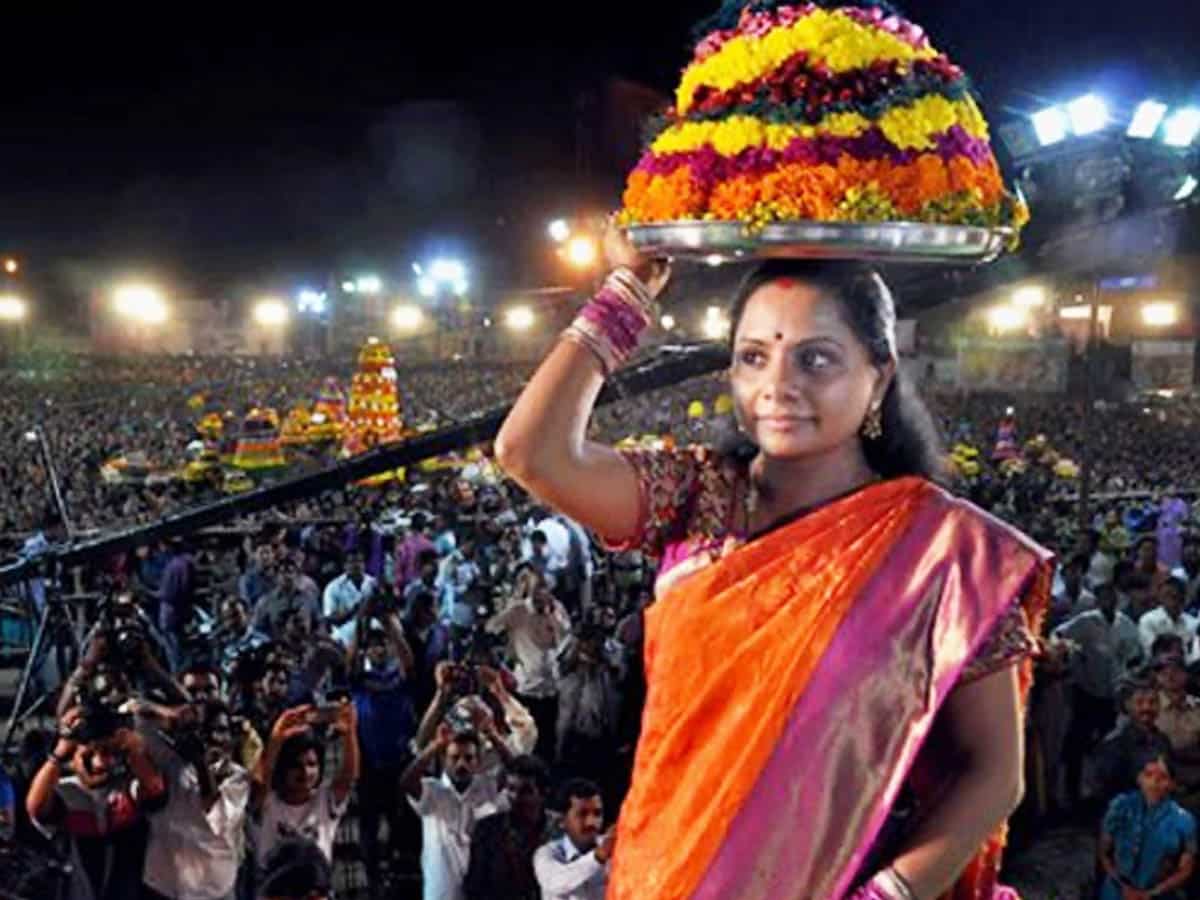
Hyderabad: Bathukamma is back and Hyderabad besides other parts of the State is rocking with festivities.
From court yards, streets and opens paces in village, towns and cities to an array of housing societies, are reverberating with ‘Bathukamma Bathukamma Uyyallo…” songs while Durga and other Shakti peethas are tastefully decorated.
Bathukamma songs and dances are famous in Jogipet in Sangareddy District, Warangal, Karimnagar, Hyderabad and other places. In Hyderabad, Bathukamma and Dandiya go hand in hand, especially among the youth.
Bathukamma means “Mother Goddess comes alive.‘ It’s a spring festival of Goddess Gauri, one of the names of Goddess Parvati, the consort of Lord Shiva and mother of Lord Ganesh. It also symbolizes the patron of Goddess womanhood.
Though the festival has adopted modern DJ, lavish settings, the traditional song and dance continues. Bathukamma festival represents the cultural spirit of Telangana, where women attired in their best sing, clap and dance in a traditional rhythmic pattern in circles around the flower decked “Bathukamma” for nine days (Navarathri).
In fact, it’s a community festival that brings all sections of women irrespective of caste and creed at one place for nine days. Men help women by bringing flowers and immerse them in ponds in the evenings after the dance rituals.
Bathukamma is a nine-day festival beginning Mahalaya Amavasya till Durgashtami, as per Sathavahana calendar and as per Gregorian calendar in September–October. This year the festival is celebrated from October 6 to 14.
During the festival, women seek prosperity, happiness, good health for themselves and their families besides unmarried women hope of a good spouse. They invoke the blessings of Goddesses.
The festival, a symbol of Telangana culture and identity like Bonalu, got a big push after the formation of Telangana State on June 2, 2014.
Though there are different stories on the origin of the festival, but it is linked to nature.
It is celebrated to thank and worship Goddess Parvati for the abundance of crops during the harvest and prosperity besides seeking bountiful harvest.
Bathukamma heralds the beauty of vibrant nature in multitudinous flowers, crops and fruits even as ponds and other water bodies are full to brim during the season.
The festival begins a week before the ‘Saddula Bathukamma’ (the grand finale of the Bathukamma festival) which falls two days before Dassera. Married women come to parents homes to celebrate the festival of flowers.
Busy all through the day, the womenfolk make Bathukammas, place them in court yard or open spaces in the evening, sing and dance rendering “Bathukamma…Bathukamma Uyyalo….songs in traditional attire and later immerse them in nearby ponds.
In the concrete jungle of cities and where there are no ponds and water bodies, women immerse in bucket full of water.
Arranging flowers for Bathukamma is an art in itself and perfected by most women over the years. Flowers are arranged in layers in a Taambalam (brass plate) in different colours and made into different sizes depending on their desire.
Commonly used flowers for Bathukamma are Gunugu puvvu (celosia), Thangedu puvvu (Cassia auriculata), Banti Puvvu (Marigold), Chamanthi puvvu (Chrysanthemum), Gummadi Puvvuv (Cucubita), Vaama puvvu (Ajwain) etc. White ‘gunuka’ flowers are dipped in myriad water colors like pink, maroon, purple, green, yellow etc.
Once Bathukamma is ready, family places it before the family deity and offer prayers. After song and dance, the Bathukammas are immersed in ponds and water bodies, share Maleeja, a dessert made with sugar and wheat bread and return home singing in praise of Bathukamma.
Each day for nine days different “Naivedyam” (food) offerings are made to Goddess.
There are different stories on its origin.
According to legend, mythology, Bathukamma is dedicated to Goddess Gauri and her battle against the demon king ‘Mahishasura’ which took place for nine days. Navarathri is celebrated for victory of good over evil.
It is also said in Telugu scripts that Daksha performed a Yagna and invited everyone except his youngest daughter, Gauri, who married Lord Shiva against his wish. In spite of Shiva’s will, Gauri went to the Yagna and she was insulted along with Lord Shiva. Insulted, she sacrificed her life in fire. To bring her back, women folk present her flowers and make turmeric idol of the Goddess and sing and dance around Bathukamma.
Another story says that King Dharmangada, the king of Chola Dynasty, named his daughter born after a long time Bathukamma, which means Life and Mother. It said the baby survived many accidents.
It is also the said the festival is to worship Goddess Lakshmi in the belief that the young girls would get good husbands as their wish.
Bathukamma for nine days have different names
- 1st day Engili Pula Bathukamma
- 2nd day Atkula Bathukamma
- 3rd day Mundapappu Bathukamma
- 4th day: Nanabiyaam Bathukamma
- 5th day: Atla Bathukamma
- 6th day Aligina Bathukamma
- 7th day Vepakayala Bathukamma
- 8th day Vennamuddala Bathukamma and
- 9th and last day Saddula Bathukamma: (For the last day, women folk prepare 5 varieties of cooked rice mixed with lemon, coconut, tamarind, curd and sesame.
C R Gowri Shanker is a seasoned journalist who has worked, among other newspapers, with Deccan Chronicle in Hyderabad

